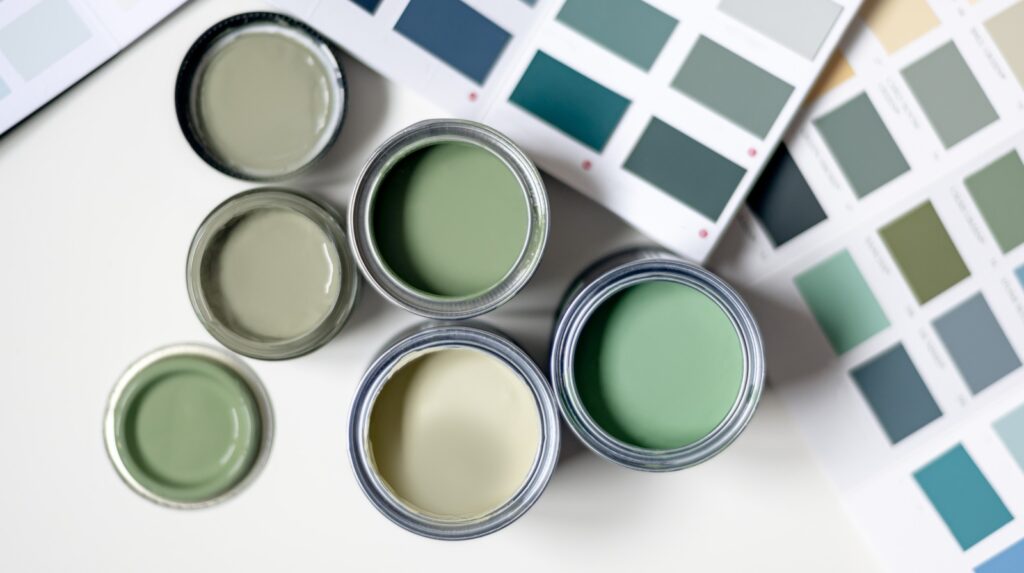Everything you ever wanted to know about the use of interior paints around your home.
Table of Contents:
- Can Interior Paint be Used Outside?
- What happens if you use interior paint outdoors?
- What is the difference between exterior and interior paint?
- Can I mix interior and exterior paint?
Can Interior Paint be Used Outside?
Using interior paint for exterior surfaces is not recommended. Interior and exterior paints are formulated differently to withstand different environmental conditions.
Exterior paints are designed to withstand exposure to sunlight, temperature fluctuations, moisture, and other weather elements. They typically contain additives that provide better UV resistance, flexibility, and durability. These characteristics help the paint withstand the harsh conditions that outdoor surfaces often face.
Interior paints, on the other hand, are not formulated to handle the challenges of the outdoors. They may not hold up well to sunlight, moisture, and temperature variations, leading to premature peeling, fading, and other deterioration.
If you use interior paint on an exterior surface, it is likely to degrade quickly, and you may find yourself needing to repaint sooner than if you had used the appropriate exterior paint. Always use the right type of paint for the specific surface and environment to ensure long-lasting and effective results.

What happens if you use interior paint outdoors?
Using interior paint outdoors can lead to several issues due to the differences in formulation between interior and exterior paints. Here are some potential problems that may arise:
- Poor Durability: Interior paints are not designed to withstand the harsh conditions of the outdoors. Exposure to sunlight, rain, wind, and temperature variations can cause the paint to break down more quickly, leading to peeling, cracking, or fading.
- Limited UV Resistance: Exterior paints typically contain UV-resistant additives to protect against sun exposure. Interior paints lack these additives, making them more susceptible to UV damage, resulting in color fading over time.
- Moisture Issues: Exterior paints often have better moisture resistance to protect against rain and humidity. Interior paints may absorb moisture, leading to problems like mold, mildew, or paint bubbling.
- Temperature Sensitivity: Exterior paints are formulated to expand and contract with temperature changes. Interior paints may not handle such fluctuations well, leading to issues like cracking or peeling when exposed to outdoor temperature variations.
- Adhesion Problems: Interior paints may not adhere well to outdoor surfaces, especially those exposed to the elements. Poor adhesion can result in the paint not sticking properly, leading to a shorter lifespan.
- Limited Protection: Exterior paints often include protective elements to guard against pollutants and environmental stressors. Interior paints lack these features, leaving the surface more vulnerable to damage.
What is the difference between exterior and interior paint?
Exterior and interior paints are formulated differently to meet the specific demands of their respective environments. Here are the key differences between the two types of paint:
- Resin Formulation:
- Exterior Paints: Typically use acrylic or latex-based resins that provide durability and flexibility. These resins help the paint withstand the challenges of outdoor exposure, such as temperature fluctuations, sunlight, and moisture.
- Interior Paints: Often use water-based or oil-based resins, depending on the type of paint. These resins may prioritize factors like ease of cleaning and a smooth finish, as interior surfaces generally do not face the same environmental stresses as exteriors.
- Additives for UV Resistance:
- Exterior Paints: Contain UV-resistant additives to prevent color fading and degradation caused by exposure to sunlight. This helps maintain the paint’s appearance over time.
- Interior Paints: Typically lack the same level of UV resistance since interior surfaces are not exposed to direct sunlight.
- Mildew and Moisture Resistance:
- Exterior Paints: Include additives that resist mildew and moisture, providing protection against rain, humidity, and other outdoor elements.
- Interior Paints: May not have the same level of moisture resistance since interior environments are generally drier.
- Flexibility and Expansion/Contraction:
- Exterior Paints: Formulated to accommodate the expansion and contraction of surfaces due to temperature changes. This flexibility helps prevent issues such as cracking and peeling.
- Interior Paints: Do not necessarily need the same degree of flexibility, as interior temperatures are more stable.
- Durability and Toughness:
- Exterior Paints: Engineered for toughness and durability to withstand weathering, abrasion, and other outdoor stressors.
- Interior Paints: Focus on providing a smooth and aesthetically pleasing finish, as interior surfaces generally do not face the same level of wear and tear.
- Volatile Organic Compounds (VOCs):
- Exterior Paints: May have lower levels of VOCs, as environmental regulations often require reduced emissions for outdoor paints.
- Interior Paints: May have varying VOC levels depending on the specific formulation, but there may be more flexibility in VOC content for interior paints.
Can I mix interior and exterior paint?
It is not recommended to mix interior and exterior paint due to their distinct formulations tailored for different environments. Interior and exterior paints have specific characteristics to address the challenges of their respective surfaces. Mixing them can compromise adhesion, durability, and weather resistance, leading to issues such as peeling and premature degradation. Additionally, aesthetic concerns may arise, as the paints may have different finishes and color stability. For optimal results, it’s advisable to use the appropriate type of paint designed for the specific surface and environmental conditions.